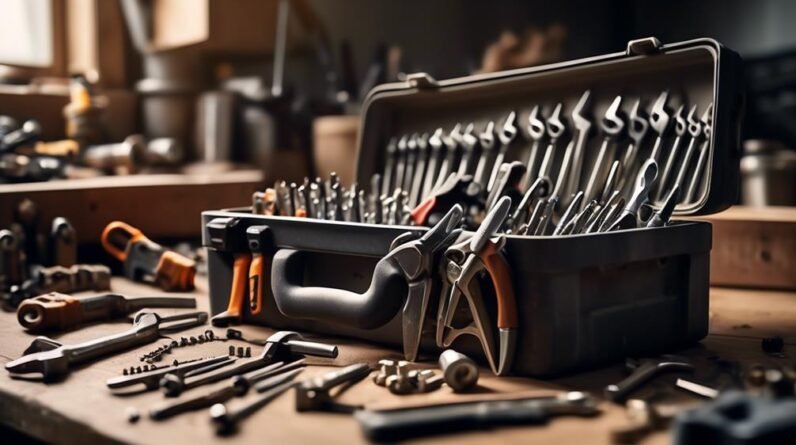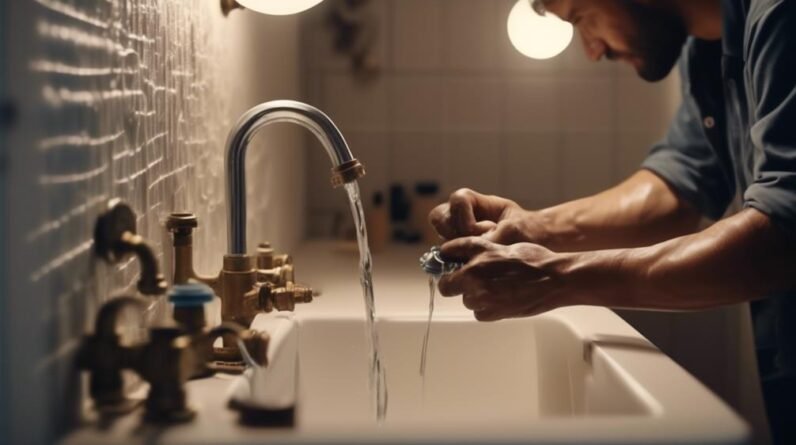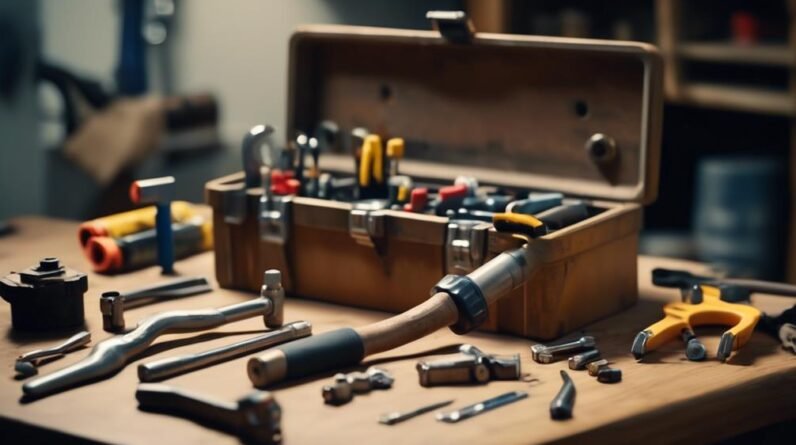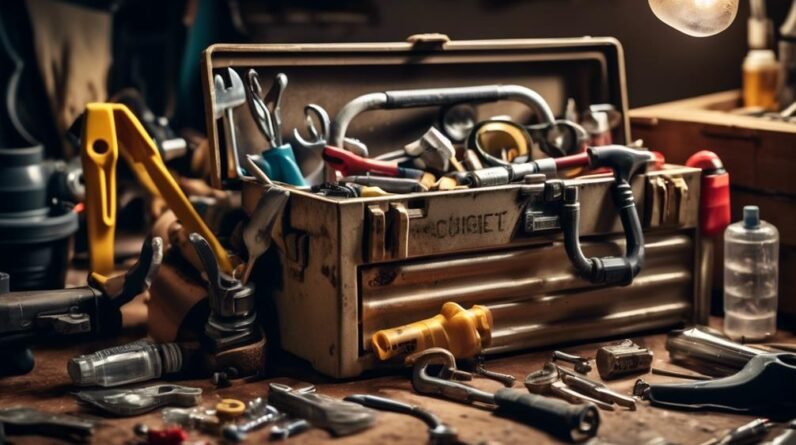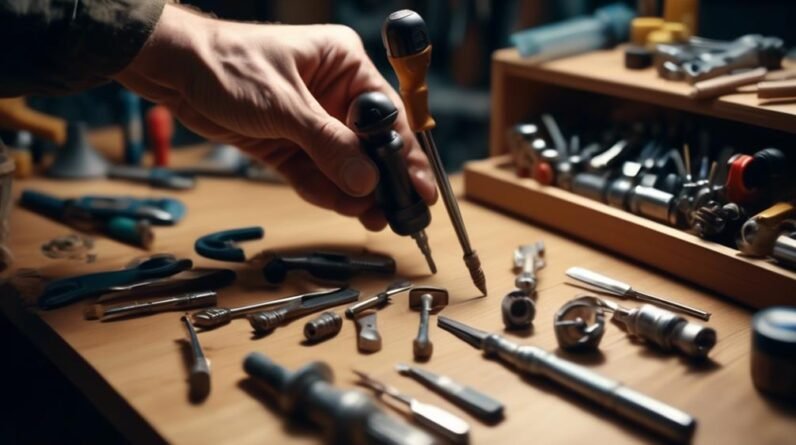
Welcome to the world of DIY home repair, where you hold the power to fix what's broken and make your humble abode shine again. Like a master of the craft, armed with your trusty toolbox and a can-do attitude, you can tackle those pesky repairs that have been nagging at you. But where do you start? How do you navigate the world of home repair without feeling overwhelmed? Fear not, for we've got you covered. In this discussion, we'll unveil simple and efficient DIY tips that will help you conquer leaky faucets, patch up wall holes, repair squeaky floorboards, unclog stubborn drains, and replace broken light switches. So, get ready to roll up your sleeves and unleash your inner handyman, because a world of home repair awaits!
Key Takeaways
- Turn off the water supply and cover the sink drain before repairing a faucet.
- Clean the area around a wall hole, apply patching compound, and sand before painting.
- Identify the cause of squeaky floorboards and reinforce them to prevent future squeaks.
- Use a plunger, natural remedies, and drain covers to unclog drains and prevent future blockages.
- Safely replace a light switch by turning off power, inspecting wire connections, and restoring power.
Fixing a Leaky Faucet
To fix a leaky faucet, you can easily follow these simple steps. First, turn off the water supply to the faucet by locating the shut-off valve under the sink. Use a wrench to tighten it clockwise until the water flow stops. Next, cover the sink drain with a cloth to prevent any small parts from falling down the drain. Now, use a screwdriver to remove the faucet handle and expose the cartridge or valve. Inspect the cartridge or valve for any signs of damage or corrosion. If necessary, replace it with a new one. Before reassembling the faucet, apply plumber's tape to the threads to prevent future leaks. Once the new cartridge or valve is in place, reattach the faucet handle and tighten the screws. Turn on the water supply and check for any leaks. If there are no leaks, congratulations! You have successfully fixed your leaky faucet. In order to prevent future leaks in faucets, it is important to perform regular maintenance such as checking for loose connections, repairing any leaks promptly, and avoiding excessive force when turning the handles.
Patching up a Hole in the Wall
If you have a hole in your wall that needs patching up, here's how to do it yourself. First, start by cleaning the area around the hole. Use a damp cloth to remove any dust or debris. Next, you'll need to gather your materials. You'll need a patching compound, a putty knife, sandpaper, and primer. Apply the patching compound to the hole, making sure to spread it evenly and fill the entire space. Use the putty knife to smooth out the surface and remove any excess compound. Allow the compound to dry completely, usually overnight. Once it's dry, use sandpaper to smooth the patched area until it's flush with the surrounding wall. Wipe away any dust with a clean cloth. Finally, apply a coat of primer to the patched area before painting over it. This will help the paint adhere properly. Once the primer is dry, you can paint over the patched wall to match the rest of the room. With these simple steps, you can repair drywall cracks and paint over patched walls with ease.
Repairing a Squeaky Floorboard
Repairing a squeaky floorboard can be a simple and effective way to eliminate annoying noises in your home. Not only can it improve the overall ambiance of your living space, but it can also prevent further damage to your floorboards. When dealing with a squeaky floorboard, it is important to identify the cause of the problem. Often, the issue is caused by loose or worn-out nails. To fix this, you can simply hammer in the loose nails or replace them with longer ones. In cases where the floorboard is scratched, you can repair it by sanding the affected area and applying a matching wood stain or sealant. Additionally, to prevent future floorboard squeaks, you can apply a lubricant, such as powdered graphite or talcum powder, to reduce friction between the boards. Another preventive measure is to reinforce the floorboards with additional screws or nails. By addressing squeaky floorboards promptly and taking measures to prevent future issues, you can enjoy a quieter and more comfortable living space.
Unclogging a Drain
When addressing household maintenance, it's important to tackle a variety of issues – like repairing a squeaky floorboard – but also be prepared to handle common plumbing problems, such as unclogging a drain. A clogged drain can be a major inconvenience, but with a few simple steps, you can easily clear it out and prevent future clogs. Here are three tips to help you unclog a drain efficiently:
- Use a plunger: A plunger is a handy tool that can quickly unclog a drain. Place the plunger over the drain and push up and down vigorously to create suction. This action will help dislodge the blockage and restore proper drainage.
- Try natural remedies: Instead of relying on harsh chemicals, consider using natural remedies to unclog your drain. Baking soda and vinegar are a powerful combination that can break down grease and debris. Pour half a cup of baking soda followed by one cup of vinegar down the drain. Let it sit for 30 minutes, then flush it with hot water.
- Install drain covers: Prevent future drain clogs by installing drain covers in your sinks and showers. These covers catch hair, soap residue, and other debris, preventing them from going down the drain and causing blockages.
Replacing a Broken Light Switch
To replace a broken light switch, start by turning off the power to the switch at the circuit breaker. This is crucial to ensure your safety while working with electrical wiring. Once the power is off, use a screwdriver to remove the faceplate of the switch. Next, unscrew the switch from the electrical box and carefully pull it out. Take note of the wire connections before disconnecting them. Common light switch problems include loose or worn-out connections, which can cause flickering lights or non-functioning switches. Inspect the wires for any signs of damage or fraying and replace them if necessary. When installing the new switch, ensure the wires are securely connected to the appropriate terminals. Finally, screw the switch back into the electrical box, attach the faceplate, and restore power at the circuit breaker. Remember to test the switch to ensure it is functioning properly. If you are unsure or uncomfortable with repairing electrical wiring, it is recommended to hire a professional electrician for assistance.
Frequently Asked Questions
How Can I Prevent a Leaky Faucet From Happening in the First Place?
To prevent a leaky faucet, you should regularly check and tighten any loose connections. If you notice a small leak, fix it immediately to prevent it from getting worse. Regular maintenance is key.
What Tools Are Needed to Patch up a Hole in the Wall?
To patch up a hole in the wall, you'll need a few basic tools like a putty knife, sandpaper, and spackle. Follow this step-by-step guide: clean the hole, apply spackle, smooth with a putty knife, sand, and paint.
Can Repairing a Squeaky Floorboard Cause Any Damage to the Rest of the Flooring?
Repairing a squeaky floorboard can potentially cause damage to the rest of the flooring if not done properly. It's important to identify the root cause of the squeak and address it to avoid any long-term effects.
Are There Any DIY Methods to Unclog a Drain That Don't Involve Using Chemicals?
You can unclog a drain without using chemicals by trying DIY methods. There are natural alternatives like using a plunger, pouring boiling water, or using a mixture of baking soda and vinegar.
Is It Necessary to Turn off the Electricity Before Replacing a Broken Light Switch?
Yes, it is necessary to turn off the electricity before replacing a broken light switch. This is an important safety precaution to avoid the risk of electric shock. Always prioritize safety in DIY home repairs.
Conclusion
In conclusion, these simple and efficient DIY home repair tips provide practical solutions to common household issues. By following these step-by-step directions, you can easily fix a leaky faucet, patch up a hole in the wall, repair a squeaky floorboard, unclog a drain, and replace a broken light switch. With a little knowledge and effort, you can save time and money by tackling these repairs yourself. Remember, being proactive in maintaining your home can prevent bigger problems down the line.


